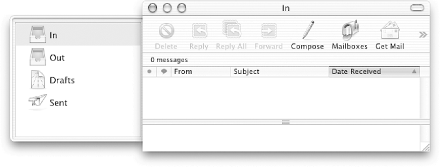Drawers
Drawers provide additional window space for an application’s interface, and can easily be tucked away from view when not in use. Drawers are ideal for controls that are frequently used, but don’t need to be visible at all times. Figure 3-9 shows an example of a drawer in Mail.
 |
The class NSDrawer
defines the behavior of drawers.
Interface Builder provides the ability to create drawers and attach
them to windows. The window that a drawer is associated with is
called the parent
window
. Like windows, drawers contain a view
hierarchy. The top-level view of this hierarchy is the
drawer’s content
view
. NSDrawer objects in
Interface Builder have outlets connected to the
drawer’s parent window and content view.
Alternatively, you can set a drawer’s parent window
of a drawer with the method setParentWindow: and
set the content view with setContentView:.
When a drawer opens or closes, it slides from an edge of the parent
window. Drawers have a preferred edge of the parent window on which
they try to open. Without sufficient room between the preferred edge
and the adjacent edge of the screen display, the drawer opens on the
opposite side of the window. The preferred edge may be any side of
the window: top, bottom, left, or right. You can access this property
with setPreferredEdge: and
preferredEdge. In these methods, the edge is represented ...
Get Cocoa in a Nutshell now with the O’Reilly learning platform.
O’Reilly members experience books, live events, courses curated by job role, and more from O’Reilly and nearly 200 top publishers.

